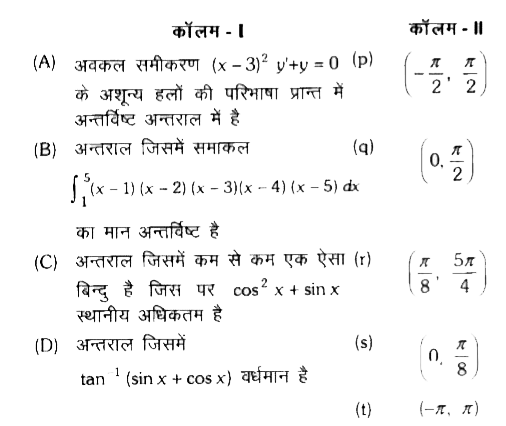यदि y=√x+√x+√x+........∞ तब dydx=
x2y−1
22y−1
−12y−1
12y−1
The correct Answer is:D
Step by step video, text & image solution for यदि y=sqrt(x+sqrt(x+sqrt(x+........oo))) तब (dy)/(dx)= by Maths experts to help you in doubts & scoring excellent marks in Class 12 exams.
Topper's Solved these Questions
- BOOK - ERRORLESS HINDICHAPTER - अवकलन तथा अवकलज के अनुप्रयोगEXERCISE - MULTIPLE CHOICE QUESTIONS (एक बिन्दु पर अवकलज,मानक अवकलज)186videos
अवकलन तथा अवकलज के अनुप्रयोग
- BOOK - ERRORLESS HINDICHAPTER - अवकलन तथा अवकलज के अनुप्रयोगEXERCISE - MULTIPLE CHOICE QUESTIONS (अस्पष्ट फलनों का अवकलन,प्रचलिक व संयुक्त फलनों का अवकलन,लघुगणकीय अवकलन, अनन्त श्रेणियों के अवकलन )64videos
अवकलन तथा अवकलज के अनुप्रयोग
- BOOK - ERRORLESS HINDICHAPTER - अवकल समीकरण EXERCISE - JEE Advanced ( Matrix Match type questions )3videos
अवकल समीकरण
- BOOK - ERRORLESS HINDICHAPTER - केन्द्रीय प्रवृत्ति के मापEXERCISE - Jee Advanced (Reasoning )2videos
केन्द्रीय प्रवृत्ति के माप
Similar Questions
2f(x)=f'(x) एवं f(0)=3, तब f(2)=
05:50View Solutionमाना y,x2x−2xxcoty−1=0 से परिभाषित x का एक अस्पष्ट फलन है। तब y'(1) बराबर है
03:22View Solution 00:53View Solution
00:53View Solutionकथन - 1 : प्रथम n सम धन पूर्णांकों का प्रसरण n2−14 है।
कथन - 2 : प्रथम n धन पूर्णाको का योगफल n(n+1)2 और प्रथम n धन पूर्णांको के वर्गों का योगफल n(n+1)(2n+1)6 है।04:02View Solutionsqrt(y-sqrt(y-sqrt(y-......till oo)))=sqrt(x+sqrt(x+sqrt(x+......til_(oo)))) then (dy)/(dx)=
05:02View SolutionIf y=√x√x....∞ then dydx is equal to
01:19View SolutionIf y=sqrt(x+sqrt(x+sqrt(x)+............oo),)(dy)/(dx)
02:31View SolutionIf y=√x+√y+√x+√y+...∞, then dydx is equal to
05:24View Solutionयदि y=√x+√y+√x+√y+...∞, हो तो, dydx का मान होगा
View SolutionIf y=√x+√x+√x.. to ∞, then dydx=
01:30View SolutionIf x=√y+√y+√y+...to∞, then: dydx=
01:55View SolutionIf y=√x+√y+√x+√y+...∞, then dydx=
02:09View SolutionIf y=√x+√y+√x+√y+...∞, then dydx =
02:25View SolutionIf y=√x+√x+√x+......∞dydx=
02:54View Solution√x+√x+√x+.....∞ হলে dy/dx -এর মান হবে—
05:43View Solutiony=√ax+√ax+√ax+−−∞ then dydx=
01:01View Solution

